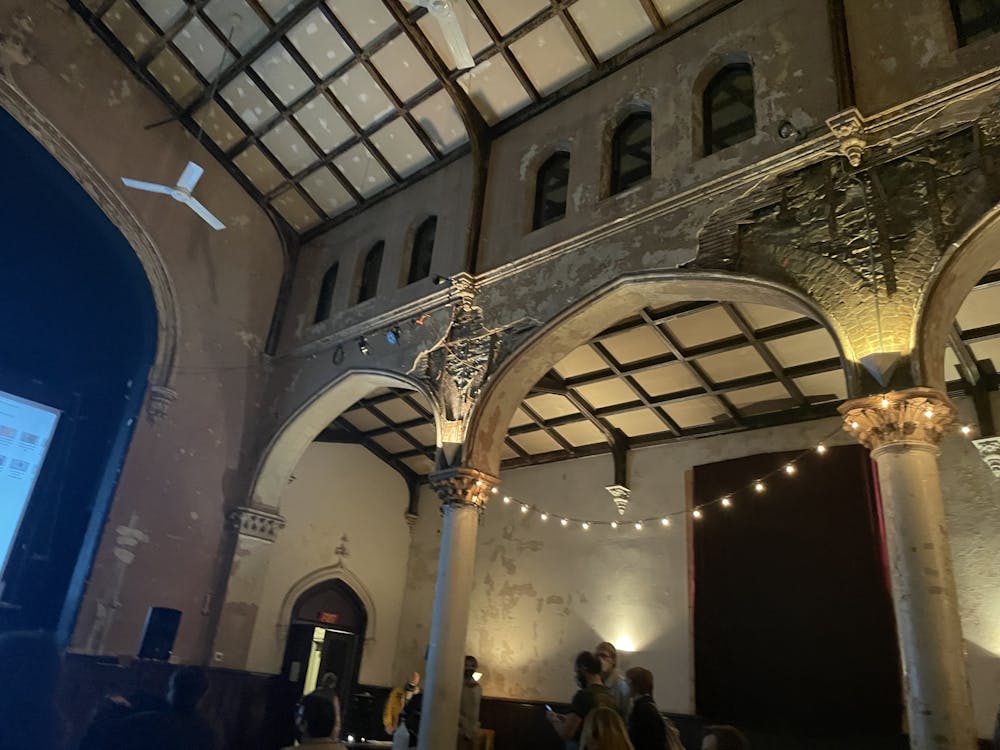In an old church on St. Paul Street down the road from Homewood Campus, a group of people congregated to attend a local film screening series known as New Works on Feb. 11. Tote bags and quirky hats abounded; there seemed to be an unspoken dress code among the audience members.
The interior of the church was peeling, revealing its dark, wooden skeleton. The ceilings soared upward and the loftiness, combined with the ethereal music playing through the speakers, engineered an expansive excitement for the event. The guests, animated and convivial, could easily have been churchgoers. But instead of God, the audience gathered around a different common belief: that experimental film, especially from the local community, is worth watching.
Jimmy Joe Roche, the founder of New Works and professor of Film and Media Studies, gave an introduction. He noted that this was the first New Works in-person screening in two years after a hiatus brought on by COVID-19. He excitedly explained the mission of New Works: to exhibit what the people of Baltimore are doing and thinking through the medium of film. He highlighted that the event was primarily for the community to showcase local creatives’ work for local viewers.
The screening began, and multiple trends emerged. The films, 11 in total, were experimental in nature. They rejected traditional narrative arcs typically manufactured by Hollywood. The camera tended to be present, knowledgeable of its own existence and a character with its own perspective. Imagery of water, too, was commonplace — though perhaps because it is so fundamental to the human experience.
A few films stood out due to their imagination and breakthrough of the art form:
The viewers were brought into the history of an abolitionist, utopian society in Florence, Mass., guided by filmmaker Mecca Lewis. Titled Florence’s Flowers, the film helped to memorialize the society that believed in each member’s equal standing at a time when slavery still existed in the nation. With imagery of the earth, produce and a statue of Sojourner Truth, Lewis makes history visceral and visual; America’s history lurks in our soil.
The only music video of the night, The Girl Who Lived In Limbo, was a gorgeous cinematic feat. Director Sihan Xu created a surrealist, dreamlike landscape for the band Jupiter Rex, effortlessly weaving stunning visuals together that vary in location. The film reflected the angst inherent in the band’s music and the vibrant colors curate a sense of youthfulness. To describe the film in one word? Energetic.
In a reference to the legendary Soviet filmmaker Dziga Vertov, Tom Borax titled his short film Man With A Movie Camera 2. Highly aware of its own construction, Borax used the camera to reveal absurdity in the most fundamental aspects of our daily routines. Unlike Vertov’s fascination with urban life, Borax centered the short mainly in the bathroom of a suburban home. Humorous and playful, the film was full of surprises and made the audience laugh out loud.
A jaunty tune populated the background of Film and Media Studies Senior Lecturer Karen Yasinsky’s animated short I’m Not Your Monster. Her sketchy, black-and-white visuals contrast with the lightness of the music. The short centered around a clear tension between a man and a woman — though other visuals appear intermittently to disorient the viewer — and the characters seem to fidget between frames. Her animations were emotionally expressive and captivating.
Toward the end of the screening, Cicada Meditation, directed by Corey Hughes, played. The camera captured the routine of cicadas from a high angle, as an omniscient overseer. The only film with a non-diegetic narrator, a woman’s voice described the minutiae of the cicadas’ activity. Immediately, a significant portion of the audience tensed up or turned away at the close-up image of an insect. The short managed to push through this discomfort, urging the viewer to see the beauty in the overlooked or undesirable.
New Works provided easy access to experimental work by Baltimore filmmakers that otherwise might be lost to the ether. Its mission to connect viewers to artists within the same community is a commendable one. A creative Friday evening detour, an experimental film screening is a great way to mix up one’s regular thought patterns and behavior with the consumption of work by people who are thinking outside of the box.





